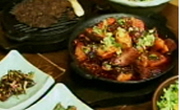이글은 고대사회에서 소가 갖는 사회경제적 양상과 역할, 그 문화와 의미가 어떠했는지를 살펴보려는 것으로 동물 중에서 대형인 소를 순화시키고 사육하는 행동이 그리 쉬운 일이 아니었...
http://chineseinput.net/에서 pinyin(병음)방식으로 중국어를 변환할 수 있습니다.
변환된 중국어를 복사하여 사용하시면 됩니다.
- 中文 을 입력하시려면 zhongwen을 입력하시고 space를누르시면됩니다.
- 北京 을 입력하시려면 beijing을 입력하시고 space를 누르시면 됩니다.
https://www.riss.kr/link?id=A107969593
- 저자
- 발행기관
- 학술지명
- 권호사항
-
발행연도
2021
-
작성언어
Korean
-
주제어
소 ; 부림짐승(役畜) ; 제례의식 ; 희생제물 ; 문화적 상징 ; Cattle ; draft animal ; ritual ceremony ; sacrifice ; cultural symbols
-
등재정보
KCI등재
-
자료형태
학술저널
-
수록면
7-48(42쪽)
- DOI식별코드
- 제공처
-
0
상세조회 -
0
다운로드
부가정보
국문 초록 (Abstract)
일반적으로 소는 사람들에게 고기를 비롯한 가죽, 뼈, 힘줄, 기름 등의 여러 재료를 제공해줄 수 있었다. 또한 深耕과 사람을 보조할 수 있는 다양한 노동력은 물론이고 여러 목적의 제례의식에 필수적인 희생물로도 활용되었다. 특히, 살아있는 사람들을 위해 많은 역할을 한 소는 이미 세상을 떠난 이들을 위해서도 수행하는 기능이 상당했는데 그것은 장송의례의 공헌물 및 부장품으로서의 작용이다. 사후세계에서도 현생의 삶을 지속할 수 있도록 죽은 이를 위한 물품을 마련하는데 소가 쓰이게 되는 것이다.
이처럼 사람들은 소를 통해 많은 것을 얻어왔고 필요한 일들을 해결했다. 소가 사람과 사회에 기여한 것은 어떻게든 우리의 역사와 삶에 그 흔적이 남으므로 선사시대를 거쳐 고대사회에 이르기까지 그런 자취들은 여러 의미나 비유로 자리하게 되고 상징화되었다고 보인다. 또한 불교가 수용된 이후 종교적 성찰까지 소에 더해져 소는 사람들의 소양과 문화로서 상징화되었으며 소의 특성이나 성품이 신비로운 의미 및 사람이 본받아야 할 품성이나 자질을 뜻하기도 하였다.
결과적으로 고대사회에서 소가 갖는 위상은 사회, 경제, 정치, 문화적으로 높을 수밖에 없었다. 가축들 중에 전쟁이란 특수한 상황에 활용되는 말을 제외하고 소가 사람들에게 가장 중요하고 특별하게 취급되는 것은 그리 이상한 일이 아니었다. 따라서 소를 통해 빚어낼 수 있는 다양한 생활문화와 의식들은 농경사회의 지속과 발전이란 측면에서 더욱 중요시되고 사람들의 삶과 밀착된 풍속으로써 우리의 전통문화를 구성하는데 일조하였다고 여겨진다.
이글은 고대사회에서 소가 갖는 사회경제적 양상과 역할, 그 문화와 의미가 어떠했는지를 살펴보려는 것으로 동물 중에서 대형인 소를 순화시키고 사육하는 행동이 그리 쉬운 일이 아니었음에도 불구하고 선사시대부터 이런 시도가 지속된 이유를 이해해보고자 한다. 또한 소를 사육하게 된 사람들의 생활상이나 소를 활용한 작업, 관련된 문화가 어떤 것인지를 고찰함으로써 소 활용의 역사 속에 전승되는 소의 기능과 가치, 상징 등이 고대 사회에 어떻게 나타나고 발달되었는지를 헤아려보고자 하는 것이다.
일반적으로 소는 사람들에게 고기를 비롯한 가죽, 뼈, 힘줄, 기름 등의 여러 재료를 제공해줄 수 있었다. 또한 深耕과 사람을 보조할 수 있는 다양한 노동력은 물론이고 여러 목적의 제례의식에 필수적인 희생물로도 활용되었다. 특히, 살아있는 사람들을 위해 많은 역할을 한 소는 이미 세상을 떠난 이들을 위해서도 수행하는 기능이 상당했는데 그것은 장송의례의 공헌물 및 부장품으로서의 작용이다. 사후세계에서도 현생의 삶을 지속할 수 있도록 죽은 이를 위한 물품을 마련하는데 소가 쓰이게 되는 것이다.
이처럼 사람들은 소를 통해 많은 것을 얻어왔고 필요한 일들을 해결했다. 소가 사람과 사회에 기여한 것은 어떻게든 우리의 역사와 삶에 그 흔적이 남으므로 선사시대를 거쳐 고대사회에 이르기까지 그런 자취들은 여러 의미나 비유로 자리하게 되고 상징화되었다고 보인다. 또한 불교가 수용된 이후 종교적 성찰까지 소에 더해져 소는 사람들의 소양과 문화로서 상징화되었으며 소의 특성이나 성품이 신비로운 의미 및 사람이 본받아야 할 품성이나 자질을 뜻하기도 하였다.
결과적으로 고대사회에서 소가 갖는 위상은 사회, 경제, 정치, 문화적으로 높을 수밖에 없었다. 가축들 중에 전쟁이란 특수한 상황에 활용되는 말을 제외하고 소가 사람들에게 가장 중요하고 특별하게 취급되는 것은 그리 이상한 일이 아니었다. 따라서 소를 통해 빚어낼 수 있는 다양한 생활문화와 의식들은 농경사회의 지속과 발전이란 측면에서 더욱 중요시되고 사람들의 삶과 밀착된 풍속으로써 우리의 전통문화를 구성하는데 일조하였다고 여겨진다.
다국어 초록 (Multilingual Abstract)
Diverse social, cultural, and economic aspects appear in the role and function of cattle in ancient society have been looked at for this purpose. First, cows were able to provide people with various materials, including meat, leather, tendons, and oil. They were used not only as a diverse workforce that could assist agriculture and people, but also as an essential sacrifice for ritual ceremonies for various purposes.
In particular, cows, which played many roles for the living, also played a role for those who were already deceased. Cows functioned as a funeral service contribution and burial item. Even in the afterlife, cows are used to prepare goods for the dead so that they can continue their lives.
In this way, people have gained a lot from cows and have resolved issues. The cow’s contribution to people and society is somehow imbued with traces of the history and lives of the people of Korea. Therefore, such traces, from prehistoric times to ancient societies, have become symbols and are symbolized in many ways. After Buddhism was accepted, the cow was symbolized as part of the people’s culture, and the cow itself held mysterious meanings characteristics or qualities that people should follow.
As a result, the status of cattle in ancient society was bound to be high socially, economically and politically, and it was not unusual for livestock to be treated with the most reverence. The various living cultures and rituals that can be created through cows are more important in terms of the continuation and development of agricultural society and are closely related to people’s lives and contribute to the formation of our traditional culture.
This article aims to look at the cultural aspects and roles of cows in ancient society, and what their meanings were. Through this article, I would like to understand why such attempts have continued since prehistoric times, even though efforts to pur...
This article aims to look at the cultural aspects and roles of cows in ancient society, and what their meanings were. Through this article, I would like to understand why such attempts have continued since prehistoric times, even though efforts to purify and raise large cattle among animals have not been easy. The article is also intended to examine how the functions, meanings, and symbols of cattle passed down in the history of cattle breeding appeared and developed in ancient society by considering lifestyles, activities related to cattle, and associated cultures.
Diverse social, cultural, and economic aspects appear in the role and function of cattle in ancient society have been looked at for this purpose. First, cows were able to provide people with various materials, including meat, leather, tendons, and oil. They were used not only as a diverse workforce that could assist agriculture and people, but also as an essential sacrifice for ritual ceremonies for various purposes.
In particular, cows, which played many roles for the living, also played a role for those who were already deceased. Cows functioned as a funeral service contribution and burial item. Even in the afterlife, cows are used to prepare goods for the dead so that they can continue their lives.
In this way, people have gained a lot from cows and have resolved issues. The cow’s contribution to people and society is somehow imbued with traces of the history and lives of the people of Korea. Therefore, such traces, from prehistoric times to ancient societies, have become symbols and are symbolized in many ways. After Buddhism was accepted, the cow was symbolized as part of the people’s culture, and the cow itself held mysterious meanings characteristics or qualities that people should follow.
As a result, the status of cattle in ancient society was bound to be high socially, economically and politically, and it was not unusual for livestock to be treated with the most reverence. The various living cultures and rituals that can be created through cows are more important in terms of the continuation and development of agricultural society and are closely related to people’s lives and contribute to the formation of our traditional culture.
목차 (Table of Contents)
- 국문초록
- Ⅰ. 여는 글
- Ⅱ. 선사시대 우리나라 소의 기원 추정과 발굴된 소의 고고유체
- Ⅲ. 고대 소의 활용과 그 사회경제적 양상
- Ⅳ. 닫는 글
- 국문초록
- Ⅰ. 여는 글
- Ⅱ. 선사시대 우리나라 소의 기원 추정과 발굴된 소의 고고유체
- Ⅲ. 고대 소의 활용과 그 사회경제적 양상
- Ⅳ. 닫는 글
- 참고문헌
동일학술지(권/호) 다른 논문
-
1920년대 부업과 공진회를 통해 본 근대조선의 물산지형 고찰
- 한국민속학회
- 김도연(Kim Do Yeon)
- 2021
- KCI등재
-
- 한국민속학회
- 김은영(Kim Eun-young)
- 2021
- KCI등재
-
- 한국민속학회
- 강정원(Jeong Won Kang)
- 2021
- KCI등재
-
- 한국민속학회
- 신영순(SHIN Youngsoon)
- 2021
- KCI등재





 DBpia
DBpia






